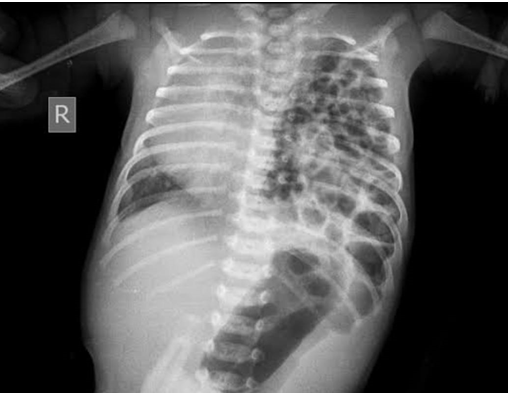Surgical Management of Congenital Diaphragmatic Hernia in Newborn
Abstract
Background: Congenital diaphragmatic hernia (CDH) is a life-threatening condition in newborns that requires prompt surgical intervention. This study aims to evaluate the outcomes of surgical management of CDH in newborns, focusing on survival rates, complications, and long-term prognosis.
Objectives: To assess the survival rate of newborns with congenital diaphragmatic hernia (CDH) who undergo surgical management.
Methods: This retrospective study was conducted at Dhaka Shishu Hospital from 2021 to 2023, involving 57 newborns diagnosed with CDH who underwent surgical repair. Preoperative stabilization, surgical techniques, postoperative care, and complications were documented. The primary outcome was survival rate, while secondary outcomes included the incidence of postoperative complications, duration of mechanical ventilation, and overall hospital stay
Result: Among the 57 newborns, among them 56.1% male and 43.8% are female. Mild genetic variant 1.3% and severe 1.2%. Cardiac malformation mild (61.4%) and severe (38.5%). Diaphragmatic defect size A and B (66.6%), C and D (22.8%). Caesarean section delivery is higher (61.4%) The most common long-term complications were thoracic deformity, intestinal obstruction and GERD. Surgical approach through abdomen (78.9%) is higher than other surgical approach. Outcome of the congenital diaphragmatic hernia of type A (38.59%)is higher among other types. Newborns with isolated CDH had a better prognosis compared to those with associated anomalies. Early surgical intervention within the first 48 hours of life was associated with improved survival rates.
Conclusion: The surgical management of CDH in newborns can lead to favorable outcomes, particularly when performed early and supported by comprehensive preoperative and postoperative care. Despite the challenges associated with CDH, prompt surgical intervention and meticulous postoperative management significantly contribute to improving survival rates and reducing complications. Further studies are needed to optimize treatment protocols and improve long-term outcomes for these patients
Downloads
References
Colvin J, Bower C, Dickinson JE, Sokol J. Outcomes of congenital diaphragmatic hernia: a population-based study in Western Australia. Pediatrics. 2005;116(3): e356–363.
Gallot D, Boda C, Ughetto S, Perthus I, Robert-Gnansia E, Francannet C, Laurichesse-Delmas H, Jani J, Coste K, Deprest J, et al. Prenatal detection and outcome of congenital diaphragmatic hernia: a French registry-based study. Ultrasound Obstet Gynecol. 2007;29(3):276–83.
Yang W, Carmichael SL, Harris JA, Shaw GM. Epidemiologic characteristics of congenital diaphragmatic hernia among 2.5 million California births, 1989– 1997. Birth Defects Res A Clin Mol Teratol. 2006;76(3):170–4.
McGivern MR, Best KE, Rankin J, Wellesley D, Greenlees R, Addor MC, Arriola L, de Walle H, Barisic I, Beres J, et al. Epidemiology of congenital diaphragmatic hernia in Europe: a register-based study. Arch Dis Child Fetal Neonatal Ed. 2015;100(2):F137–144.
Tennant PW, Samarasekera SD, Pless-Mulloli T, Rankin J. Sex differences in the prevalence of congenital anomalies: a population-based study. Birth Defects Res A Clin Mol Teratol. 2011;91(10):894–901
Brownlee EM, Howatson AG, Davis CF, Sabharwal AJ. The hidden mortality of congenital diaphragmatic hernia: a 20-year review. J Pediatr Surg. 2009; 44(2):317–20.
Mah VK, Zamakhshary M, Mah DY, Cameron B, Bass J, Bohn D, Scott L, Himidan S, Walker M, Kim PC. Absolute vs relative improvements in congenital diaphragmatic hernia survival: what happened to “hidden mortality”. J Pediatr Surg. 2009;44(5):877–82.
Stege G, Fenton A, Jaffray B. Nihilism in the 1990s: the true mortality of congenital diaphragmatic hernia. Pediatrics. 2003;112(3 Pt 1):532–5.
Jancelewicz T, Langham MR Jr, Brindle ME, Stiles ZE, Lally PA, Dong L, et al. Survival benefit associated with the use of extracorporeal life support for neonates with congenital diaphragmatic hernia. Ann Surg. 2022;275(1): e256---63. PMID: 33060376.
Reed-McCullough S, Jnah AJ. Congenital diaphragmatic hernia: core review and novel updates. Neonatal Netw. 2021;40(5):305---12. PMID: 34518382.
Luco M, Salas G, Zavala A, Otano˜ J, Toso A, Reusmann A, et al. Risk-stratified results among congenital diaphragmatic hernia patients in two large extracorporeal membrane oxygenation centers in South America. J Pediatr Surg. 2023;58(7):1230---4, http://dx.doi.org/10.1016/j.jpedsurg.2023.01.058. Epub 2023 Feb 15. PMID: 36918323.
Congenital Diaphragmatic Hernia Study GroupLally KP, Lally PA, Lasky RE, Tibboel D, Jaksic T, Wilson JM, et al. Defect size determines survival in infants with congenital diaphragmatic hernia. Pediatrics. 2007;120(3): e651---7, http://dx.doi.org/10.1542/peds.2006-3040. PMID: 17766505.
Putnam LR, Harting MT, Tsao K, Morini F, Yoder BA, Luco M, et al. Congenital diaphragmatic hernia defect size and infant morbidity at discharge. Pediatrics. 2016;138(5): e20162043.
Salas GL, Otano˜ JC, Cannizzaro CM, Mazzucchelli MT, Goldsmit GS. Hernia diafragmática congénita: predictores posnatales de mortalidad. Arch Argent Pediatr. 2020;118(3):173---9.
Harting MT, Lally KP. The Congenital Diaphragmatic Hernia Study Group registry update. Semin Fetal Neonatal Med. 2014;19(6):370---5.
Congenital Diaphragmatic Hernia Study GroupLally KP, Lasky RE, Lally PA, Bagolan P, Davis CF, Frenckner BP, et al. Standardized reporting for congenital diaphragmatic hernia: an international consensus. J Pediatr Surg. 2013;48(12):2408---15.
Koziarkiewicz M, Taczalska A, Piaseczna-Piotrowska A. Long term follow-up of children with congenital diaphragmatic hernia: observations from a single institution. Eur J PediatrSurg. 2014;24(6):500---7.
Chock VY, Danzer E, Chung S. In-hospital morbidities for neonates with congenital diaphragmatic hernia: the impact of defect size and laterality. J Pediatr. 2022; 240:94---101, e6. PMID: 34506854.
Morini F, Valfrè L, Capolupo I, Lally KP, Lally PA, Bagolan P. Congenital diaphragmatic hernia: defect size correlates with developmental defect. J Pediatr Surg. 2013;48(6):1177---82.
Heiwegen K, de Blaauw I, Botden SMBI. A systematic review and meta-analysis of surgical morbidity of primary versus patch repaired congenital diaphragmatic hernia patients. Sci Rep. 2021;11(1):12661. PMID: 34135386; PMCID: PMC8209041.
Guglielmetti LC, Estrada AE, Phillips R, Staerkle RF, Gien J, Kinsella JP, et al. Congenital diaphragmatic hernias: severe defect grade predicts the need for fundoplication. Medicine (Baltimore). 2020;99(49): e23383, http://dx.doi.org/ 10.1097/MD.0000000000023383. PMID: 33285723; PMCID: PMC7717763.
Hunter CE, Saenz ZM, Nunez D, Timsina L, Gray BW. Interand intra-rater reliability of a grading system for congenital diaphragmatic hernia defect size. J Surg Res. 2019; 233:82---7. PMID: 30502292



























